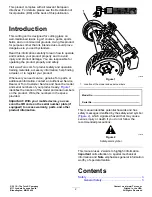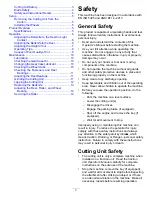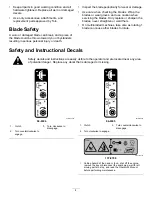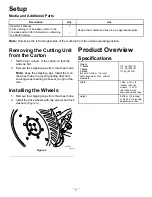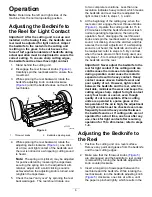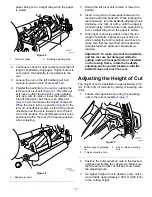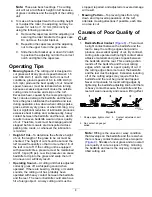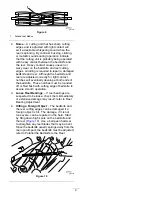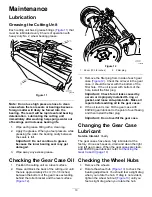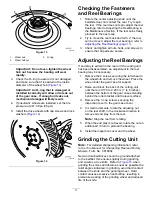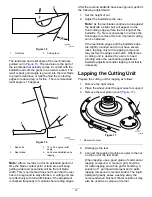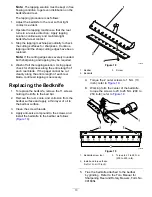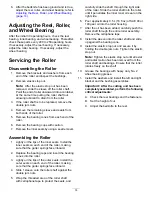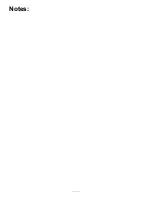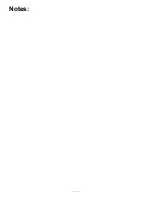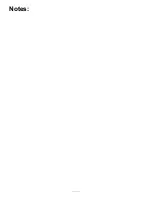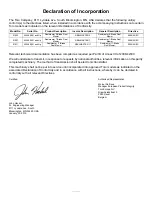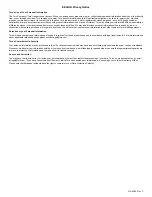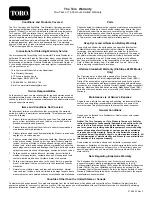
Note:
These are bench settings. The cutting
unit will cut at a different height in turf because
of grass conditions and the weight of the cutting
unit.
4.
To make a finer adjustment to the cutting height
or to adjust the roller, the adjusting nut may be
moved 1/2 notch or 1.19 mm (3/64 inch) by
using the following procedure:
A.
Remove the capscrew and the adjusting nut
securing the roller bracket to the gear case.
Do not move the roller bracket.
B.
Reposition the capscrew and the adjusting
nut to the upper hole in the gear case.
C.
Slide the roller bracket up or down 1/2 notch
to position the adjusting nut into the correct
notch and tighten the capscrew.
Operating Tips
•
Mowing Speed
—The cutting unit is designed to
cut grass well at any ground speed between 1.6
and 9.66 km/h (1 and 6 mph) but for most turf
conditions, ground speeds of 6.4 to 9.66 km/h (4
to 6 mph) produce the best quality of cut. Ground
speed, however, must be reduced when turning
because excessive speed will cause the outside
cutting units to bounce and skip on the turf.
Excessive heat, caused by the reel spinning too
fast, can also damage the bedknife and the reel.
Since the grass lubricates the bedknife and reel
during operation, slow down when cutting sparse
grass, extremely dry grass, or when trimming. Any
lack or significant reduction of lubrication produces
excessive heat buildup and, subsequently, heavy
contact between the bedknife and the reel, which
results in uneven bedknife wear and poor quality
of cut. Therefore, reels must be disengaged and
stopped before mowers are transported across
parking lots, roads, or whenever the lubrication
is minimal.
•
Height of Cut
—To determine the effective height
of cut, the length of the grass to be cut must be
checked. The height of cut should be set and the
turf mowed frequently so that no more than 1/3 of
the leaf is cut off. If the cutting unit is equipped
with pneumatic tires, pressure must be maintained
at 241.3 kpa (35 psi). Low tire pressure can cause
bedknife to dip into the grass and scalp the turf.
An uneven cut will likely result.
•
Operating Sound
—A cutting unit that is adjusted
correctly gives off a whispering sound when
operated. If there are buzzing, clicking, or metallic
sounds, the cutting unit has probably been
operated with heavy contact between the bedknife
and the reel. The reel or bedknife could also have
hit a foreign object. A noisy cutting unit must be
stopped, repaired, and adjusted or severe damage
will result.
•
Mowing Pattern
—To prevent grass from lying
down and improved appearance of the turf,
alternate mowing directions if possible, each time
an area is cut.
Causes of Poor Quality of
Cut
1.
Bedknife/Reel Contact
(
) – There must
be light contact between the bedknife and the
reel to keep the cutting edges sharp and to
produce an excellent quality of cut. By contrast,
cutting units operated without light contact allow
abrasive materials and grass to pass between
the bedknife and the reel. This eroding action
rounds off the bedknife and the reel cutting
edges, which results in a poor quality of cut. If
the cutting edges become round, the bedknife
and the reel must be lapped. Excessive rounding
off of the cutting edges may require that the
bedknife and the reel be ground and lapped.
Never compensate for round cutting edges by
tightening the bedknife adjusting knob until there
is heavy contact because the bedknife and the
reel will wear unevenly and cause a rifling effect.
g026931
Figure 8
1.
Sharp edges, light contact
3.
Contact adjustment, dull
edges
2.
No contact, edges get
dulled
Note:
Rifling is the uneven or wavy condition
that develops on the bedknife and the reel when
there is heavy contact between these two parts
(
). Streaks of uncut grass and an overall
poor quality of cut are signs of rifling. Grinding
the bedknife and reel is the only way to repair a
rifled cutting unit.
8


